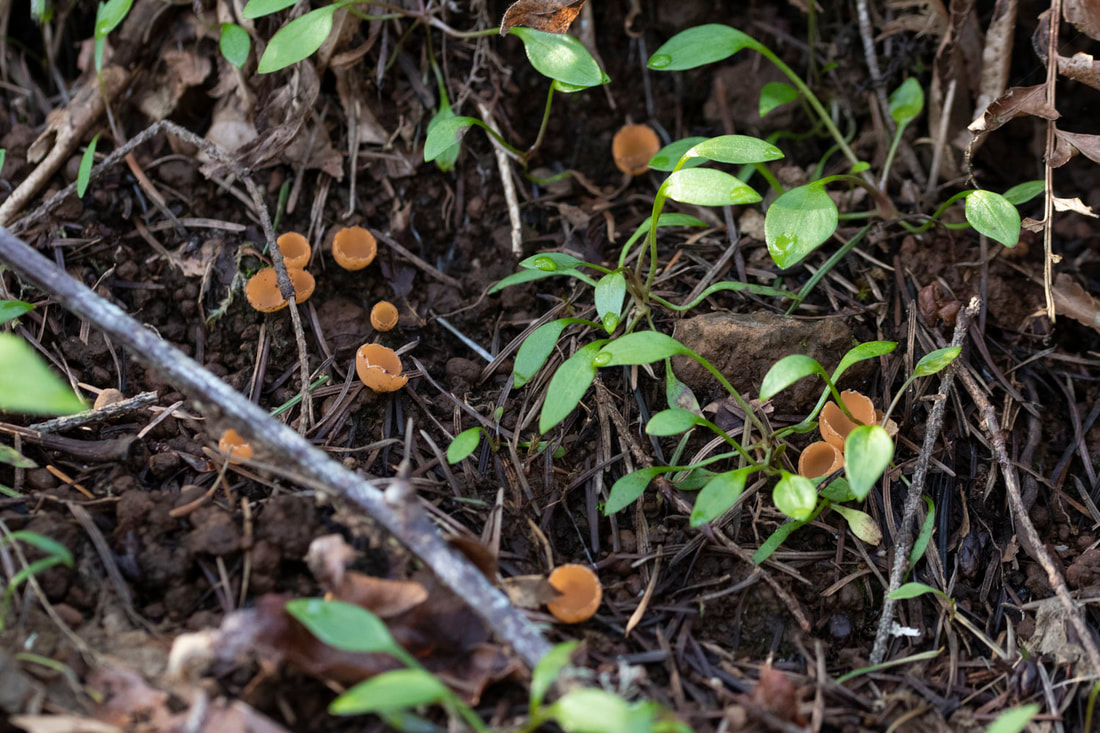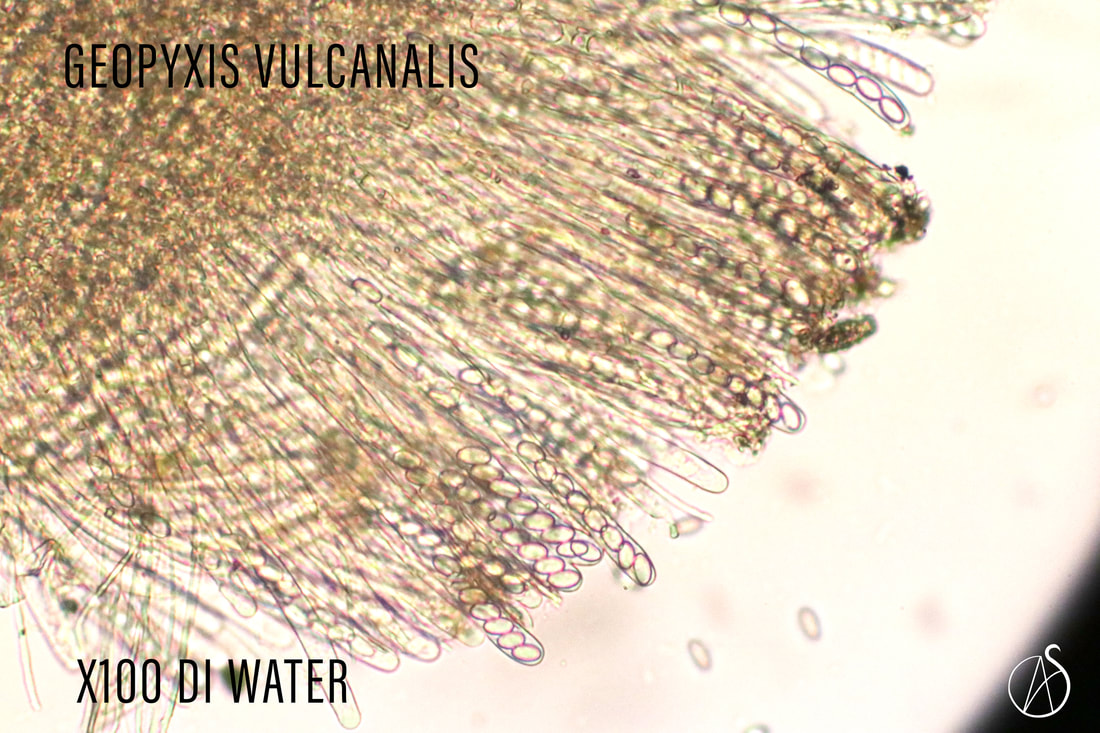Complex Geopyxis alpina
These bright little yellow/orange cup fungi fruit all over the soil, like little polk-a-dots in the duff. I first noticed them after we crossed a little bridge and were climbing our way up an S curve on a trail. These little cups were flushed on the soil along the edges of the trail and up the sides of the embankment. We stopped to observe them and I gathered a few to take home and look at under the microscope.
When I got home, I remembered a tip that my mentor suggested. He told me to crush them and smell them, and see what I got. So I crushed them, and smelled them and almost gagged! Then I grabbed a handful, crushed those and ran to stick them under my partner's nose without warning. He is used to me shoving things in his face and asking his opinion. But when he smelled this he gave me a disgusted look and squinted at me. It smelled like a sewer, or rotting eggs, like the sulphur hot springs but wouldn't dissipate. I knew that had to be a key character to finding the identity, so I looked and found Geopyxis vulcanalis.
When I got home, I remembered a tip that my mentor suggested. He told me to crush them and smell them, and see what I got. So I crushed them, and smelled them and almost gagged! Then I grabbed a handful, crushed those and ran to stick them under my partner's nose without warning. He is used to me shoving things in his face and asking his opinion. But when he smelled this he gave me a disgusted look and squinted at me. It smelled like a sewer, or rotting eggs, like the sulphur hot springs but wouldn't dissipate. I knew that had to be a key character to finding the identity, so I looked and found Geopyxis vulcanalis.
I did a bit more reading into these and found out one of their common names is "fairy farts". And when you crush them, they definitely stink!
Since I began this Art of Fungi project the name has changed on this little mushroom. With DNA sequencing becoming the standard for ID and naming, this mushroom has been sequenced and the name has changed. As they sort things out, this little orang cup fungi is now called Complex Geopyxis alpina, as the G. Vulcanalis does not even exist any more. The renaming and discovery of fungi is constantly in flux as fungi gets sequenced and citizen scientists help gather samples. I expect a large number of the fungi I find to be renamed in my lifetime.
Complex Geopyxis alpina
Classification:
Fungi
Dikarya
Ascomycota
Pezizomycotina
Pezizomycetes
Pezizomycetidae
Pezizales
Pyronemataceae
Geopyxis
Description:
Cup: .3- 1/5 cm across, orange to buff yellow, cup shaped with scalloped edges when old.
Hymenium surface: buff yellow to orange, smooth and dry.
Stipe: has a rudimentary, ridged stipe central to the cup,
Flesh: whitish, thin and fragile
Odor: smells like sulphur gas
Spores: 14x8 um, elliptical with narrowing ends
Found in small troops on soil, or in moss or duff.
Classification:
Fungi
Dikarya
Ascomycota
Pezizomycotina
Pezizomycetes
Pezizomycetidae
Pezizales
Pyronemataceae
Geopyxis
Description:
Cup: .3- 1/5 cm across, orange to buff yellow, cup shaped with scalloped edges when old.
Hymenium surface: buff yellow to orange, smooth and dry.
Stipe: has a rudimentary, ridged stipe central to the cup,
Flesh: whitish, thin and fragile
Odor: smells like sulphur gas
Spores: 14x8 um, elliptical with narrowing ends
Found in small troops on soil, or in moss or duff.
Resources:
Arora, David (1986). Mushrooms Demystified, 2nd ed.
Beug, Michael W., Alan E. Bessette, & Arleen R. Bessette. (2014). Ascomycete Fungi of North America: A Mushroom Reference Guide. University of Texas Press, Austin, Texas.
Largent, David & David Johnson. How to Identify Mushrooms to Genus III: Microscopic Features
Siegel, Noah and Christian Schwarz (2016). Mushrooms of the Redwood Coast: A Comprehensive Guide to Fungi of Coastal Northern California
Trudell, Steve & Joe Ammirati (2009). Mushrooms of the Pacific Northwest
Wang XH, Huhtinen S, Hansen K. Multilocus phylogenetic and coalescent-based methods reveal dilemma in generic limits, cryptic species, and a prevalent intercontinental disjunct distribution in Geopyxis (Pyronemataceae s. l., Pezizomycetes). Mycologia. 2016 Nov/Dec;108(6):1189-1215. doi: 10.3852/16-100. PMID: 27760850.
My iNaturalist observations:
https://www.inaturalist.org/observations/39078902
Arora, David (1986). Mushrooms Demystified, 2nd ed.
Beug, Michael W., Alan E. Bessette, & Arleen R. Bessette. (2014). Ascomycete Fungi of North America: A Mushroom Reference Guide. University of Texas Press, Austin, Texas.
Largent, David & David Johnson. How to Identify Mushrooms to Genus III: Microscopic Features
Siegel, Noah and Christian Schwarz (2016). Mushrooms of the Redwood Coast: A Comprehensive Guide to Fungi of Coastal Northern California
Trudell, Steve & Joe Ammirati (2009). Mushrooms of the Pacific Northwest
Wang XH, Huhtinen S, Hansen K. Multilocus phylogenetic and coalescent-based methods reveal dilemma in generic limits, cryptic species, and a prevalent intercontinental disjunct distribution in Geopyxis (Pyronemataceae s. l., Pezizomycetes). Mycologia. 2016 Nov/Dec;108(6):1189-1215. doi: 10.3852/16-100. PMID: 27760850.
My iNaturalist observations:
https://www.inaturalist.org/observations/39078902










